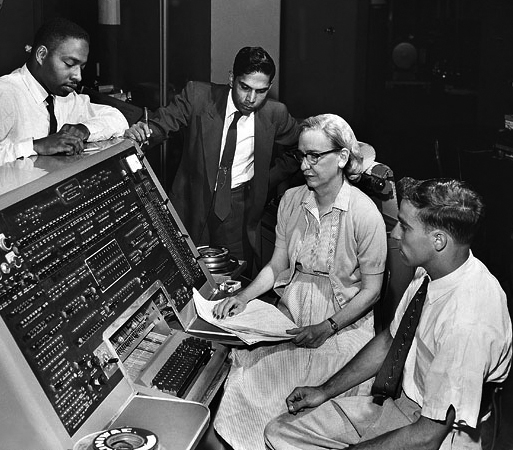
A Sunday New York Times article by David Streitfeld has the feminist and tech worlds up in arms. Reporting on a sexual harassment suit filed by a junior partner in a venture capital firm, Streitfeld begins by proclaiming that “MEN invented the Internet” (those CAPS are his). I came across Streitfeld’s article after a friend suggested I check out tech journalist Xeni Jardin’s Twitter feed. Jardin’s response to Streitfeld:
WTF: “MEN invented the internet.” I’m sorry, did NYT just breeze past half a century of women in computer technology?
Herein lies the issue: Though Streitfeld primarily covers Ellen Pao’s lawsuit, he undermines his piece by leading with an emphatic and incorrect statement about men as sole inventors of the Internet. I’m not certain if Streitfeld was being tongue-in-cheek or if he simply has a narrow view of Internet history. But his article does incite, albeit unintentionally, necessary dialogue about the roles women–and racial and ethnic minorities–have played in Internet innovation. While some apparently assume that men alone developed the Internet, a quick glance at the Internet Hall of Fame’s 2012 inaugural inductees and the Early Internet Leaders list prove otherwise. (I also recommend reading History of the Internet).
In reality, the genesis of the Internet was a collaborative effort. It took decades of developments in computer programming and network technology. We can’t let the current cult of tech fandom around “white” men–such as Steve Jobs, whom Streitfeld name checks–obscure the women and the racial and ethnic minorities from around the world who contributed to the birth of the Internet.
But I get it. For those who want to trace the Internet to a specific point of origin, there’s a tempting one to be had: the work of DARPA, a military research program that in 1969 launched ARPANET, the packet switching network that is the foundation of the modern-day Internet. Since the early Internet was a project of the U.S. military, we credit its development to a government institution primarily headed by men (although Elizabeth Feinler also pioneered the early ARPANET platform). Even if we focus more broadly on the late ’60s and ’70s development of the network protocols that shaped early Internet platforms, we still find mostly men—with the exception of Radia Perlman, a.k.a the “Mother of the Internet.” The relative absence of women and racial and ethnic minorities during this period of tech innovation is not surprising given the oppression these groups faced in both public and private spheres, which largely kept them out of the field.
But to zero in on the DARPA era is to accept a myopic view of Internet history. The Internet was enabled by more than the development of electrical and optical networking infrastructure; it also required programming-language innovations, which eventually enabled more sophisticated communication to occur between networks. If we zoom back out and survey the computer programming landscape of the early 20th century, we see women such as Grace Hopper, who developed COBOL, a foundational language of web programming still in use today. To discuss early innovation of the Internet is to recognize that women also led the way in shaping computer and network technology.
That said, it isn’t necessarily productive to frame conversations about Internet innovation by which gender or race is primarily responsible for its inception, given that the origin of the Internet is about the ideas of many people. While we chuckle upon hearing that Al Gore invented the Internet 30 years after the infrastructure of the Internet was already in place, there is a sense in which Gore was a pioneer of the Internet: not because he invented codes and protocols, but rather because he sponsored legislation during the ’90s that funded public access to the Information Superhighway. If we can credit Gore as an Internet innovator despite having nothing at all to do with developing its infrastructure three decades prior, then surely we can credit women whose development of early coding language, network protocol and ARPANET influenced networked infrastructure pre-, during and post-DARPA. Certainly we can credit Ada Lovelace, a mathematician of the 19th century who is considered the world’s first computer programmer. And, of course, there’s an entire history of mathematics we can link to the African Diaspora!
You get the point.
The history of the Internet is untidy and perhaps best understood as a web—opposed to a timeline—of development. When we acknowledge that the history of the Internet is as interconnected as the medium itself, we recognize that women and men of various backgrounds contributed to what we now know as the modern-day Internet.
To learn about today’s women tech innovators, read Laura Sydell’s “Women of the Valley” in the current issue of Ms.





